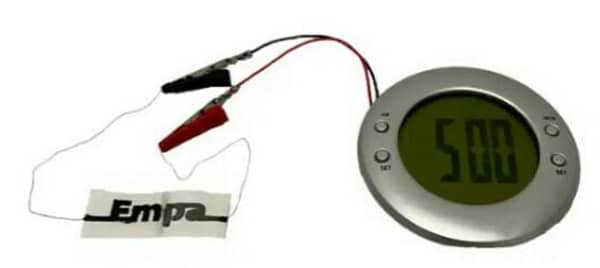To put it in simple words, Paper batteries are made with cellulose paper and Carbon Nanotubes.Through a process called carbonisation which converts paper into pure carbon, the researchers turned the paper’s fibres into electrodes. Such systems can be made into rechargeable batteries that power mobile phones, medical equipment, and other nano electronic devices. Such batteries can minimise environmental pollution caused by traditional batteries to a great extent. The battery is water- activated and could be applied to a broad range of single-use electronic devices.
How It Works?
This battery, developed by Gustav Nyström and colleagues, consists of at least one cell that is one centimetre square and is made up of three inks that have been printed on a rectangular piece of paper. The paper strip is covered with sodium chloride salt, and one of its shorter ends has been dipped in wax. One of the flat sides of the paper is printed with ink containing graphite flakes, which serves as the positive end of the battery (cathode). The other side is printed with ink containing zinc powder, which serves as the negative end of the battery ( anode ). In addition, on top of the other two inks, an ink containing graphite flakes and carbon black is printed on both sides of the paper. This ink links the battery’s positive and negative ends to two wires positioned at the wax-dipped end of the paper. The salts in the paper dissolve when a small quantity of water is added, releasing charged ions. These ions spread across the paper to activate the battery, which causes the zinc in the ink at the negative end of the battery to release electrons. Attaching the wires to an electrical device closes the circuit so that electrons can be transferred from the negative end via the graphite and – carbon black-containing ink, wires, and device – to the positive end (the graphite-containing ink) where they are transferred to oxygen in the surrounding air. These reactions generate an electrical current that can be used to power the device.

To demonstrate the ability of their battery to run low-power electronics, the authors combined two cells into one battery and used it to power an alarm clock with a liquid crystal display. Analysis of the performance of a one- cell battery revealed that after two drops of water were added, the battery activated within 20 seconds and, when not connected to an energy-consuming device, reached a stable voltage of 1.2 volts. Voltage of the standard alkaline AA battery is 1.5 volts. After one hour, the one-cell battery’s performance decreased significantly due to the paper drying. However, after two more drops of water were added, it maintained a stable operating voltage of 0.5 volts for more than one additional hour.
Advantages
- Paper Batteries are thin, rugged, and flexible
- Lightweight.
- hey can be cut, rolled, and made in any shape.
- Paper Batteries are non-toxic and environmentally friendly. Hence, they can power a pacemaker.
- Paper Batteries provide steady power.
- They are available in many shapes.
Disadvantages
- They have low shear strength. As a result they tore easily.
- The methods (e.g. arc discharge, CVD, ablation, electrolysis) used in carbon nanotubes manufacturing are expensive and less efficient. They are harmful to human beings when inhaled.
Applications
- It could be used to power a broad variety of low-power, single-use disposable electronics.
- Smart labels for tracking items 3)Environmental sensors.
- Medical diagnostic devices.
- Medical patch.
- Melody card.
- RFID tag.
Conclusion
Biodegradability of paper and zinc could enable their battery to minimise the environmental pollution . Thus these low-power electronics batteries can increase the efficiency of power electronics and reduce the cost of batteries to a great extent.
Vinayak Ramachandra Adkoli is a B. E. in Industrial Production and served as lecturer in three different polytechnics for 10 years. I am also a freelance writer and cartoonist.






Although this Paper Battery is really an innovative idea,its manufacturing process seems hazardous to the manufacturer himself! Furthermore, the huge expenses caused by the Carbonizing the paper fibers into Carbon Nano-tubes will hinder this products acceptance.